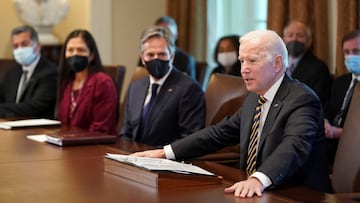What’s in the infrastructure bill Biden signed into law? Who attended the ceremony?
Biden signed into law a landmark bipartisan infrastructure bill on Monday with lawmakers from both parties attending a ceremony held at the White House.

In a rare moment of bipartisanship in Washington, President Biden signed the $1.2 trillion Infrastructure and Investment Act put together by a group of 21 senators from both parties and passed with support of Democrats and Republicans. The signing ceremony saw state and local officials, as well as lawmakers from both sides of the aisle in attendance at the gathering.
With the Biden’s signature, the largest investment in US infrastructure in nearly seven decades can get underway. According to President Biden, with the legislation, the US will outpace China in infrastructure investments for the first time in recent decades. “We’re on the cusp of an infrastructure decade” Biden said.
Also see:
- The Supreme Court case that is deciding the future of Puerto Rico
- These states are still sending their own stimulus checks
- La Palma eruption claims life of volunteer worker
- India forces late amendment to COP26 agreement
Who attended the bipartisan infrastructure bill signing at the White House?
The sweeping bipartisan infrastructure bill, which was passed by the evenly split Senate with a 69 to 30 vote in August, languished in the House awaiting a vote as Democrats worked out the Build Back Better companion bill. A majority of progressives holding back their votes to ensure that the Democrat-only bill made it through Congress in tandem finally relinquished with a promise from moderates to vote for the second larger bill once the Congressional Budget Office releases its score for the “care economy” bill expected on Friday.
Even so, with a razor thin majority in the lower chamber, Speaker Nancy Pelosi got the bill over the finish line with the help of 13 House Republicans counterbalancing six progressives that voted “No.” Despite the bipartisan support in Congress, not all the GOP lawmakers were in attendance that voted for the bill. In the end six Republican senators and two GOP House members were present.
The bipartisan infrastructure package is good for America. Today, I attended the White House signing ceremony for this bill I negotiated with nine of my colleagues that will make the most significant infrastructure investment since the Interstate Highway System in the 1950s. pic.twitter.com/BkP5IGpUMk
— Sen. Susan Collins (@SenatorCollins) November 15, 2021
They included Representatives Don Young of Alaska and Tom Reed of New York, along with Senators Bill Cassidy of Louisiana, Lisa Murkowski of Alaska, Mitt Romney of Utah, Shelley Moore Capito of West Virginia, Susan Collins of Maine, Rob Portman of Ohio who spoke at the ceremony.
Also in attendance at the rare bipartisan gathering were state and local officials from across the country and political spectrum. Labor leaders, including from the Teamsters and United Auto Workers, as well as business leaders from Ford, United Airlines and US Chamber of Commerce among others took part in the ceremony.
What is in the bipartisan infrastructure bill?
Related stories
The $1.2 trillion infrastructure bill includes around $550 billion in new spending over five years, on top of funding Congress was already planning to allocate for infrastructure over the next eight years. This money will make a series of long-overdue investments in the nation’s roads, bridges, mass transit, along with airports, ports and waterways. Earlier this year the American Society of Civil Engineers report card gave the nation’s infrastructure system a C- score.
President Biden just signed the Bipartisan Infrastructure Deal into law. This is a once-in-a-generation investment in clean water, high-speed internet, public transit, roads, bridges, and more. pic.twitter.com/CfjPTvQgom
— The White House (@WhiteHouse) November 15, 2021
Amtrak will get funding for its largest expansion since it was created 50 years ago. Additionally, funding will go toward investments to help transition to electric vehicles, including building a network of charging stations across the US. Upgrading and building more resilient power and water systems, as well as cleaning up past pollution. Investment in broadband will give households across the US faster and more secure internet connections which became vital during the pandemic.


